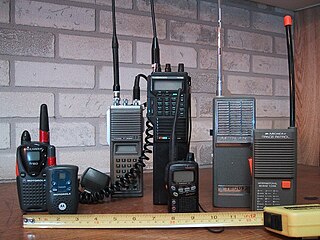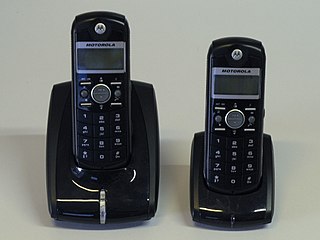The ISM radio bands are portions of the radio spectrum reserved internationally for industrial, scientific and medical (ISM) purposes, excluding applications in telecommunications. Examples of applications for the use of radio frequency (RF) energy in these bands include radio-frequency process heating, microwave ovens, and medical diathermy machines. The powerful emissions of these devices can create electromagnetic interference and disrupt radio communication using the same frequency, so these devices are limited to certain bands of frequencies. In general, communications equipment operating in ISM bands must tolerate any interference generated by ISM applications, and users have no regulatory protection from ISM device operation in these bands.

Frequency-hopping spread spectrum (FHSS) is a method of transmitting radio signals by rapidly changing the carrier frequency among many distinct frequencies occupying a large spectral band. The changes are controlled by a code known to both transmitter and receiver. FHSS is used to avoid interference, to prevent eavesdropping, and to enable code-division multiple access (CDMA) communications.

Citizens band radio, used in many countries, is a land mobile radio system, a system allowing short-distance person-to-many persons bidirectional voice communication among individuals, using two way radios operating on 40 channels near 27 MHz (11 m) in the high frequency band. Citizens band is distinct from other personal radio service allocations such as FRS, GMRS, MURS, UHF CB and the Amateur Radio Service. In many countries, CB operation does not require a license, and it may be used for business or personal communications. Like many other land mobile radio services, multiple radios in a local area share a single frequency channel, but only one can transmit at a time. The radio is normally in receive mode to receive transmissions of other radios on the channel; when users want to talk they press a "push to talk" button on their radio, which turns on their transmitter. Users on a channel must take turns talking. Transmitter power is limited to 4 watts in the US and the EU. CB radios have a range of about 3 miles (4.8 km) to 20 miles (32 km) depending on terrain, for line of sight communication; however, various radio propagation conditions may intermittently allow communication over much greater distances.

Pirate radio or a pirate radio station is a radio station that broadcasts without a valid license.
In-band on-channel (IBOC) is a hybrid method of transmitting digital radio and analog radio broadcast signals simultaneously on the same frequency. The name refers to the new digital signals being broadcast in the same AM or FM band (in-band), and associated with an existing radio channel (on-channel). By utilizing additional digital subcarriers or sidebands, digital information is "multiplexed" on existing signals, thus avoiding re-allocation of the broadcast bands.
In telecommunications, Continuous Tone-Coded Squelch System or CTCSS is one type of in-band signaling that is used to reduce the annoyance of listening to other users on a shared two-way radio communication channel. It is sometimes referred to as tone squelch. It does this by adding a low frequency audio tone to the voice. Where more than one group of users is on the same radio frequency, CTCSS circuitry mutes those users who are using a different CTCSS tone or no CTCSS. It is sometimes referred to as a sub-channel, but this is a misnomer because no additional channels are created. All users with different CTCSS tones on the same channel are still transmitting on the identical radio frequency, and their transmissions interfere with each other; however; the interference is masked under most conditions. The CTCSS feature also does not offer any security.

The Family Radio Service (FRS) is an improved walkie-talkie radio system authorized in the United States since 1996. This personal radio service uses channelized frequencies around 462 and 467 MHz in the ultra high frequency (UHF) band. It does not suffer the interference effects found on citizens' band (CB) at 27 MHz, or the 49 MHz band also used by cordless telephones, toys, and baby monitors. FRS uses frequency modulation (FM) instead of amplitude modulation (AM). Since the UHF band has different radio propagation characteristics, short-range use of FRS may be more predictable than the more powerful license-free radios operating in the HF CB band.

A walkie-talkie, more formally known as a handheld transceiver (HT), is a hand-held, portable, two-way radio transceiver. Its development during the Second World War has been variously credited to Donald Hings, radio engineer Alfred J. Gross, Henryk Magnuski and engineering teams at Motorola. First used for infantry, similar designs were created for field artillery and tank units, and after the war, walkie-talkies spread to public safety and eventually commercial and jobsite work.
The General Mobile Radio Service (GMRS) is a land-mobile FM UHF radio service designed for short-distance two-way communication and authorized under part 95 of 47 USC. It requires a license in the United States, but some GMRS compatible equipment can be used license-free in Canada. The US GMRS license is issued for a period of 10 years by the FCC. The United States permits use by adult individuals who possess a valid GMRS license, as well as their immediate family members. Immediate relatives of the GMRS system licensee are entitled to communicate among themselves for personal or business purposes, but employees of the licensee who are not family members are not covered by the license. Non-family members must be licensed separately.
Code of Federal Regulations, Title 47, Part 15 is an oft-quoted part of Federal Communications Commission (FCC) rules and regulations regarding unlicensed transmissions. It is a part of Title 47 of the Code of Federal Regulations (CFR), and regulates everything from spurious emissions to unlicensed low-power broadcasting. Nearly every electronics device sold inside the United States radiates unintentional emissions, and must be reviewed to comply with Part 15 before it can be advertised or sold in the US market.

A cordless telephone or portable telephone is a telephone which has a portable handset but which one can use like landline phone communication; such telephones operate using radio-frequency transmission rather than a physical insulated wire or a direct connection to a telephone line. A cordless telephone's base station connects with the telephone network through a telephone line and also includes a charger to charge the handset's batteries. The operational range is limited, usually to the same building or within some short distance from the base station.
In the United States, the business band is the colloquial name used by radio users who utilize, and scanner hobbyists who listen to, the Federal Communications Commission (FCC) Industrial/Business pool frequencies. The regulations listing frequencies in this pool are contained in Subpart C of Part 90, Title 47 of the CFR.

A two-way radio is a radio that can both transmit and receive radio waves, unlike a broadcast receiver which only receives content. It is an audio (sound) transceiver, a transmitter and receiver in one unit, used for bidirectional person-to-person voice communication with other users with similar radios. Two-way radios are available in stationary, mobile, and hand-held portable models. Hand-held two-way radios are often called walkie-talkies, handie-talkies or hand-helds. Two-way radios are used by groups of geographically separated people who need to keep in continuous voice communication, such as aircraft pilots and air traffic controllers, ship captains and harbormasters, emergency services personnel like firefighters, police officers, and ambulance paramedics, taxi and delivery services, soldiers and military units, fast food and warehouse employees, and radio amateurs.

PMR446 is a licence exempt service in the UHF radio frequency band and is available for business and personal use in most countries throughout the European Union.
MOTO Talk is a feature on some Motorola iDEN cellular phone handsets which allows users to make short-range 'push-to-talk' calls to other such handsets without being on the iDEN network. This feature goes by different names on iDEN service providers. In the US, Nextel called it 'DirectTalk' and included it as a free service on most new models of Motorola handsets. Boost Mobile disabled the function via handset software settings. SouthernLINC calls it LINCaround and ships handsets with the feature disabled. It can be enabled after paying an activation fee of $20. In Canada, TELUS calls it "Mike's Talk-Around."

A wireless microphone, or cordless microphone, is a microphone without a physical cable connecting it directly to the sound recording or amplifying equipment with which it is associated. Also known as a radio microphone, it has a small, battery-powered radio transmitter in the microphone body, which transmits the audio signal from the microphone by radio waves to a nearby receiver unit, which recovers the audio. The other audio equipment is connected to the receiver unit by cable. In one type the transmitter is contained within the handheld microphone body. In another type the transmitter is contained within a separate unit called a "bodypack", usually clipped to the user's belt or concealed under their clothes. The bodypack is connected by wire to a "lavalier microphone" or "lav", a headset or earset microphone, or another wired microphone. Most bodypack designs also support a wired instrument connection. Wireless microphones are widely used in the entertainment industry, television broadcasting, and public speaking to allow public speakers, interviewers, performers, and entertainers to move about freely while using a microphone without requiring a cable attached to the microphone.
In the United States, the Citizens Band Radio Service (CBRS), commonly called citizens band radio, is one of several personal radio services defined under Title 47 of the Code of Federal Regulations, Part 95. It is intended to be a two-way voice communication service for use in personal and business activities of the general public, and has a reliable communications range of several miles, though the range is highly dependent on type of radio, antenna and propagation.
In telecommunications, white spaces refer to radio frequencies allocated to a broadcasting service but not used locally. National and international bodies assign frequencies for specific uses and, in most cases, license the rights to broadcast over these frequencies. This frequency allocation process creates a bandplan which for technical reasons assigns white space between used radio bands or channels to avoid interference. In this case, while the frequencies are unused, they have been specifically assigned for a purpose, such as a guard band. Most commonly however, these white spaces exist naturally between used channels, since assigning nearby transmissions to immediately adjacent channels will cause destructive interference to both.

Citizens band radio is a system of short-distance radio communications between individuals on a selection of channels within the 27-MHz band. In India, this frequency band extends from 26.957 MHz to 27.283 MHz. There are several different channel plans in use. Citizens band is distinct from the Family Radio Service, GMRS, Multi-Use Radio Service and amateur radio (Ham). In many countries CB operation does not require a license, and it may be used for business or personal communications. Like many other two-way radio services, any citizens band channel is shared by many users. Only one station may transmit in a channel at a time; other stations must listen and wait for the shared channel to be available. Also, the system works in half-duplex mode, which means we may transmit and receive information, but not both at the same time.

A personal radio service is any system that allows individual to operate radio transmitters and receivers for personal purposes with minimal or no special license or individual authorization. Personal radio services exist around the world and typically use light-weight walkie talkie portable radios. The power output, antenna size, and technical characteristics of the equipment are set by regulations in each country. Many regions have standardized personal radio service rules to allow travelers from one country to use their equipment in another country. Examples of standardized services include PMR446 and FM Citizens Band Radio (CB) in the EU and several other countries/regions. 26–27 MHz CB radio is the oldest personal radio service and is used in nearly every country worldwide, with many countries and regions copying the United States 40-channel frequency plan. In many countries, CB radio is less popular due to the availability of other personal radio services that offer shorter antennas, better protection from noise and interference.











